Otobong Nkanga
There’s No Such Thing as Solid Ground
10 Jul - 13 Dec 2020
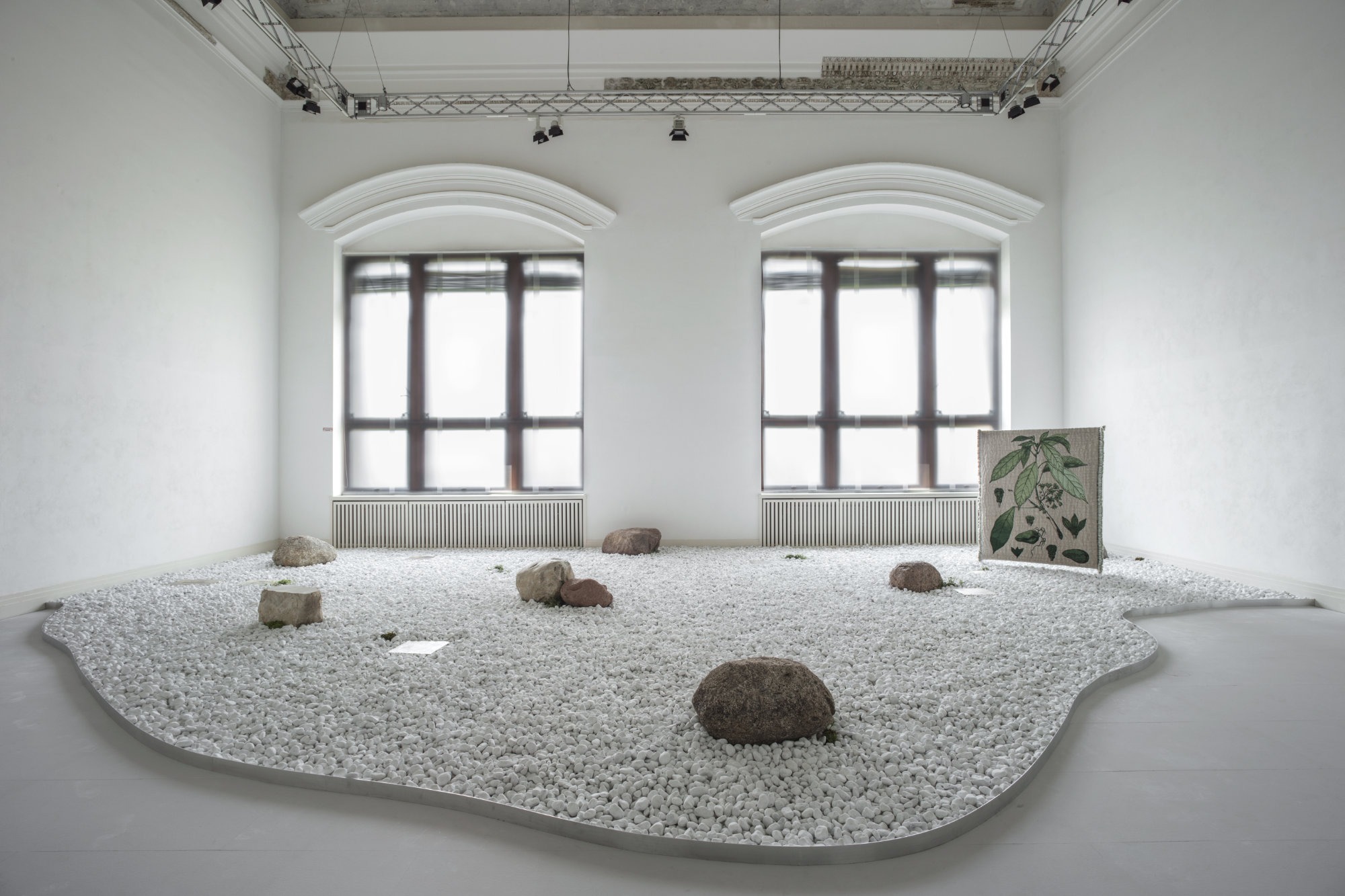
Otobong Nkanga, Taste of a Stone, 2020
Site-specific installation, boulders, gneiss, granite, iceland lichen, inkjet prints on limestone, marble pebbles, movements, plants
Installation view Otobong Nkanga: There's No Such Thing as Solid Ground, Gropius Bau, Berlin, 2020
© Otobong Nkanga, photo: Luca Giradini
Site-specific installation, boulders, gneiss, granite, iceland lichen, inkjet prints on limestone, marble pebbles, movements, plants
Installation view Otobong Nkanga: There's No Such Thing as Solid Ground, Gropius Bau, Berlin, 2020
© Otobong Nkanga, photo: Luca Giradini

Otobong Nkanga, Taste of a Stone (Detail), 2020
Site-specific installation, boulders, gneiss, granite, iceland lichen, inkjet prints on limestone, marble pebbles, movements, plants
Installation view Otobong Nkanga: There's No Such Thing as Solid Ground, Gropius Bau, Berlin, 2020
© Otobong Nkanga, photo: Luca Giradini
Site-specific installation, boulders, gneiss, granite, iceland lichen, inkjet prints on limestone, marble pebbles, movements, plants
Installation view Otobong Nkanga: There's No Such Thing as Solid Ground, Gropius Bau, Berlin, 2020
© Otobong Nkanga, photo: Luca Giradini
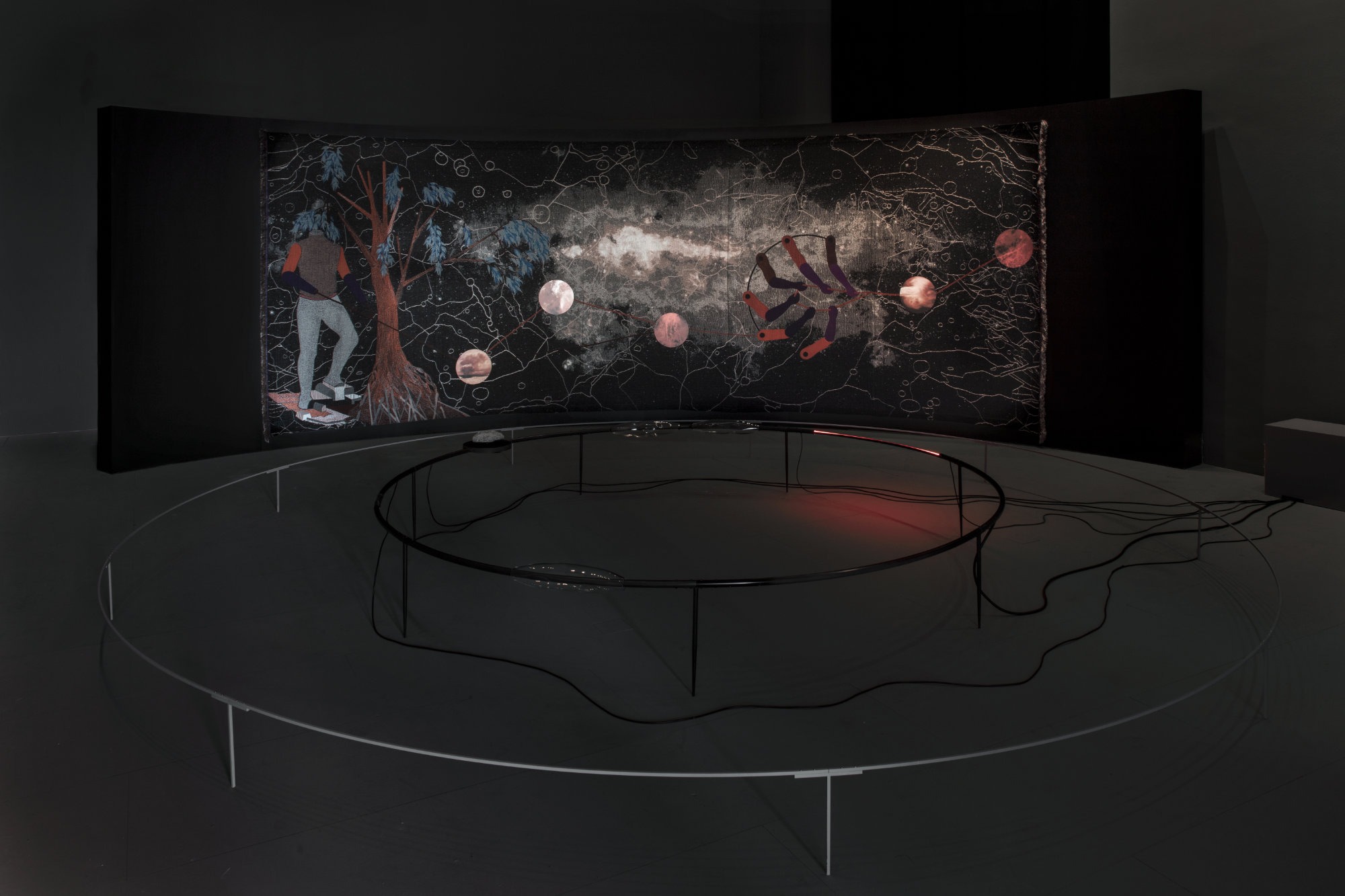
Otobong Nkanga, Double Plot, 2018
Tapestry: woven textile and photography; yarns: acryl and inkjet print on 5 laser cut metal plates, bio cotton, cashwool, polyester, viscose bast
Installation view Otobong Nkanga: There's No Such Thing as Solid Ground, Gropius Bau, Berlin, 2020
© Otobong Nkanga, Photo : Luca Giardini
Tapestry: woven textile and photography; yarns: acryl and inkjet print on 5 laser cut metal plates, bio cotton, cashwool, polyester, viscose bast
Installation view Otobong Nkanga: There's No Such Thing as Solid Ground, Gropius Bau, Berlin, 2020
© Otobong Nkanga, Photo : Luca Giardini
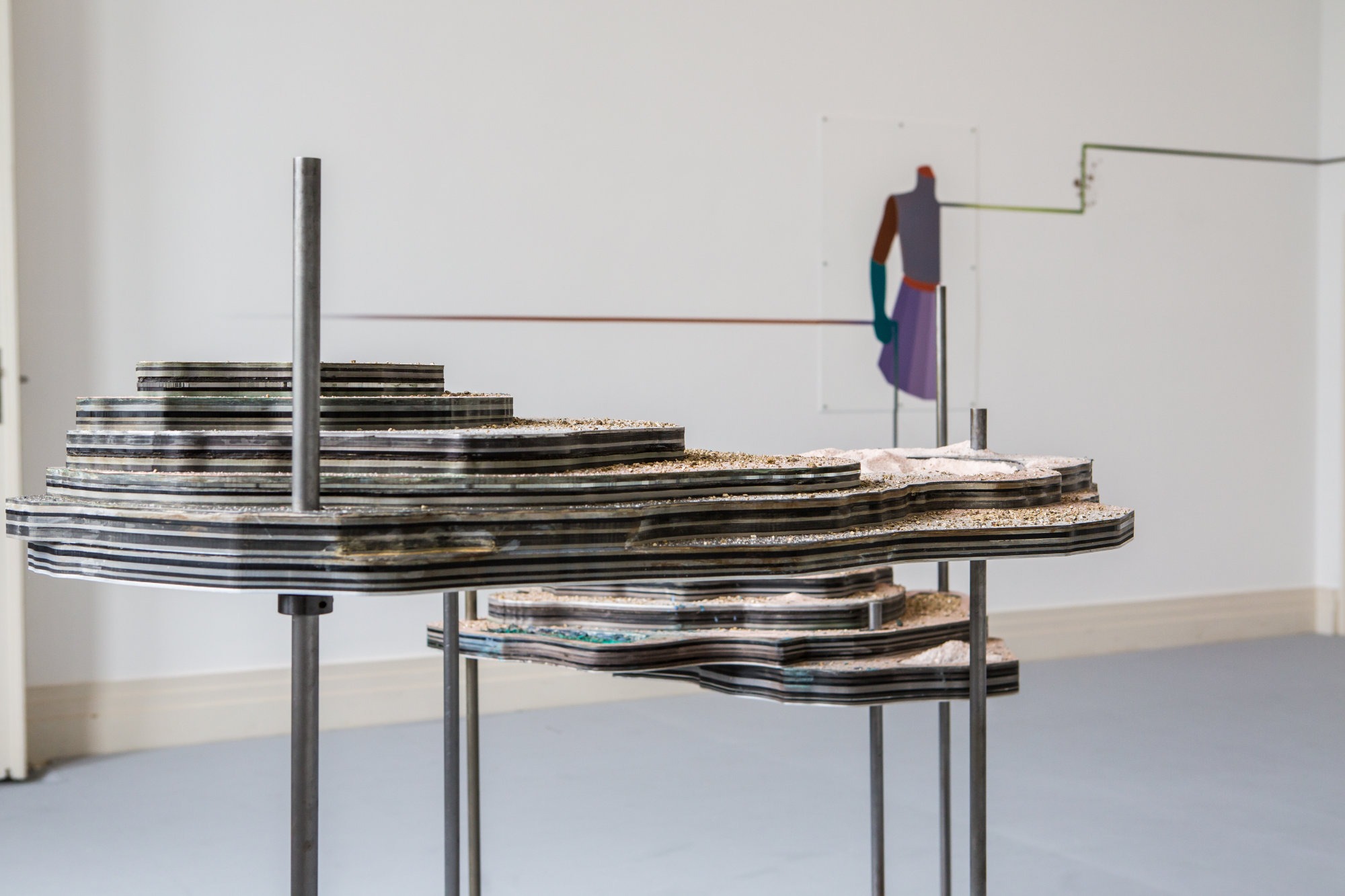
Otobong Nkanga, Solid Maneuvers, 2015
Various metals, acrylic, Forex, make-up, salt, tar, vermiculite
Installation view Otobong Nkanga: There's No Such Thing as Solid Ground, Gropius Bau, Berlin, 2020
© Otobong Nkanga, Foto: Laura Fiorio
Various metals, acrylic, Forex, make-up, salt, tar, vermiculite
Installation view Otobong Nkanga: There's No Such Thing as Solid Ground, Gropius Bau, Berlin, 2020
© Otobong Nkanga, Foto: Laura Fiorio

Otobong Nkanga, Solid Maneuvers, 2015
Installation view Crumbling Through Powdery Air, Portikus, 2015
Photo: Helena Schlichting, courtesy: Portikus
Installation view Crumbling Through Powdery Air, Portikus, 2015
Photo: Helena Schlichting, courtesy: Portikus
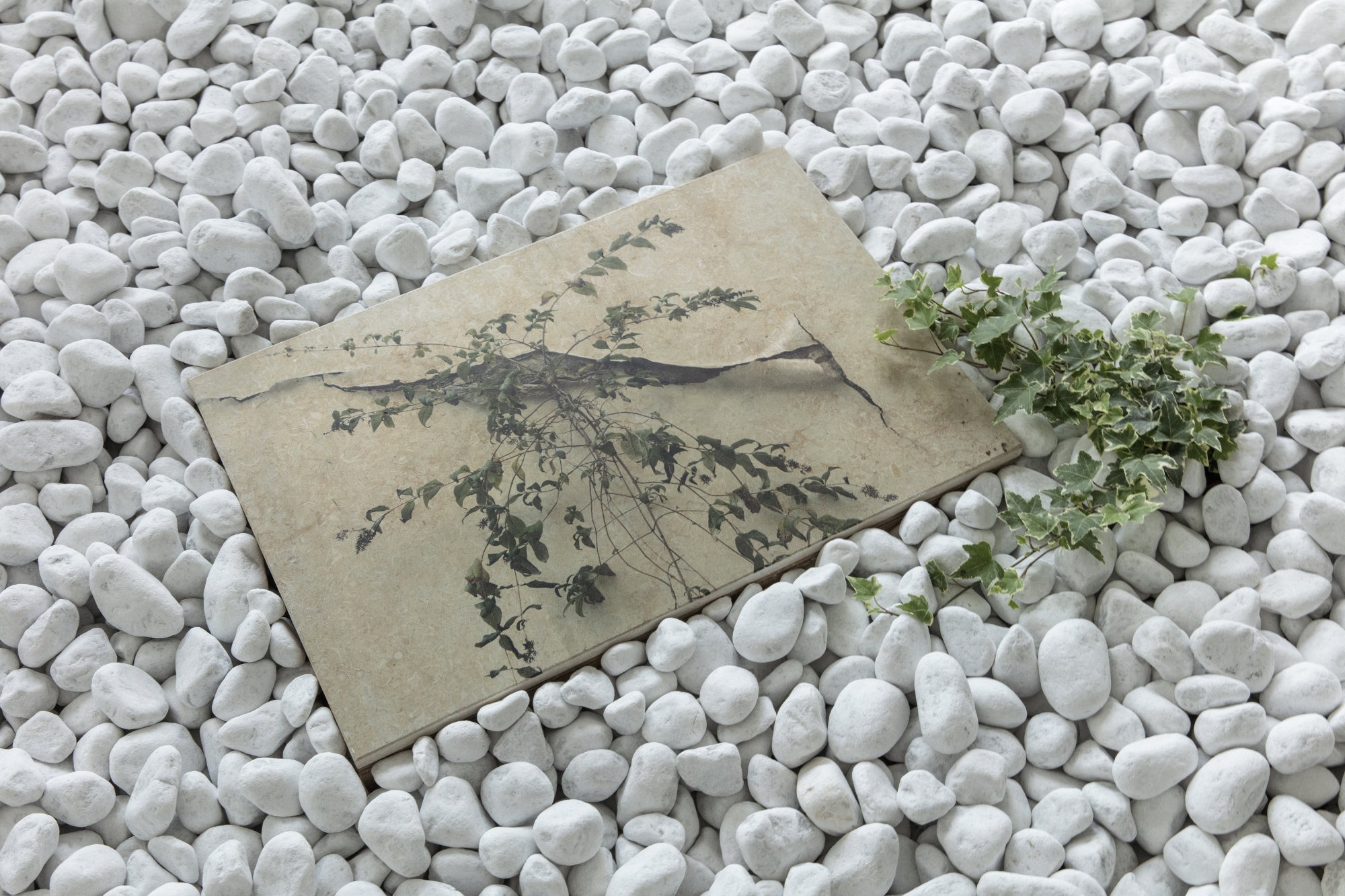
Otobong Nkanga, Taste of a Stone (Detail), 2020
Site-specific installation, boulders, gneiss, granite, iceland lichen, inkjet prints on limestone, marble pebbles, movements, plants
Installation view Otobong Nkanga: There's No Such Thing as Solid Ground, Gropius Bau, Berlin, 2020
© Otobong Nkanga, photo: Luca Giradini
Site-specific installation, boulders, gneiss, granite, iceland lichen, inkjet prints on limestone, marble pebbles, movements, plants
Installation view Otobong Nkanga: There's No Such Thing as Solid Ground, Gropius Bau, Berlin, 2020
© Otobong Nkanga, photo: Luca Giradini
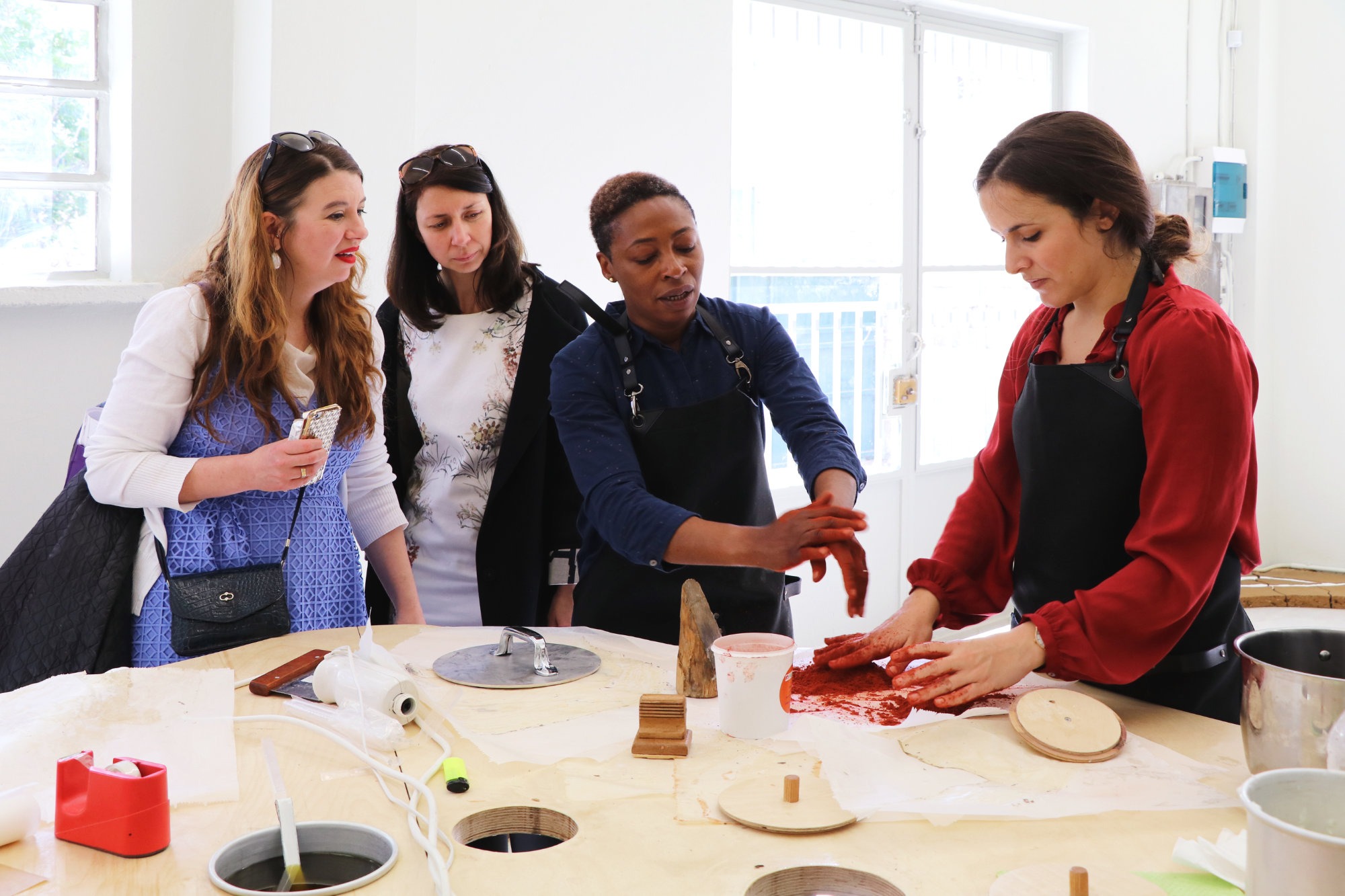
Otobong Nkanga, Carved to Flow, 2017
Public program sessions, The Workstation, 2017 (collaboration with Evi Lachana and Maya Tounta), documenta 14, Athens
© Otobong Nkanga, photo: Wim van Dongen
Public program sessions, The Workstation, 2017 (collaboration with Evi Lachana and Maya Tounta), documenta 14, Athens
© Otobong Nkanga, photo: Wim van Dongen
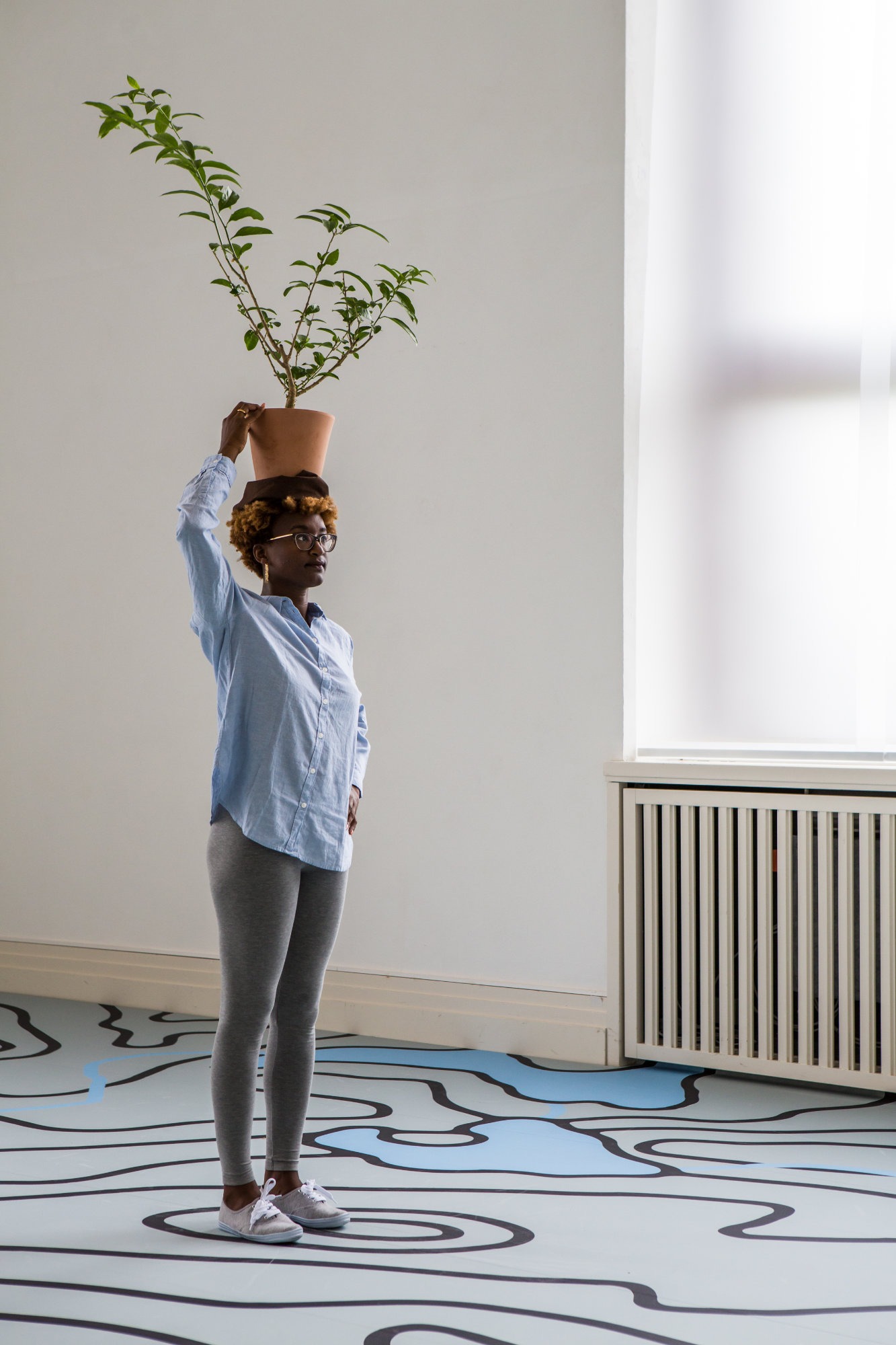
Otobong Nkanga, Diaspore, 2020
Site-specific installation, performance, printed vinyl floor, Cestrum Nocturnum, plant pots
Otobong Nkanga: There's No Such Thing as Solid Ground, Gropius Bau, Berlin, 2020
© Otobong Nkanga, Foto: Laura Fiorio
Site-specific installation, performance, printed vinyl floor, Cestrum Nocturnum, plant pots
Otobong Nkanga: There's No Such Thing as Solid Ground, Gropius Bau, Berlin, 2020
© Otobong Nkanga, Foto: Laura Fiorio
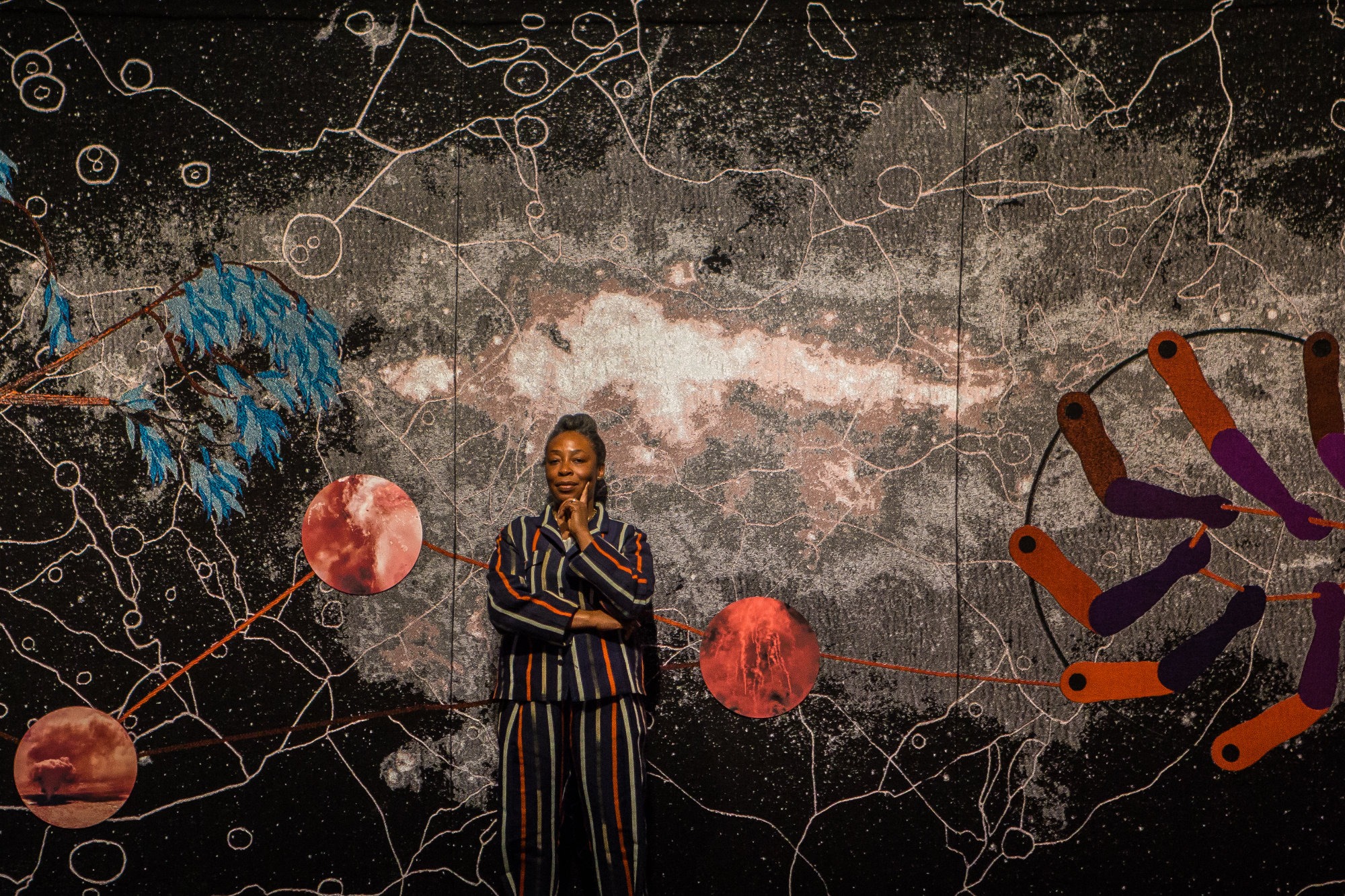
Otobong Nkanga, Double Plot, 2018
Otobong Nkanga in front of her work Double Plot
Otobong Nkanga: There's No Such Thing as Solid Ground, Gropius Bau, Berlin, 2020
© Otobong Nkanga, Foto: Laura Fiorio
Otobong Nkanga in front of her work Double Plot
Otobong Nkanga: There's No Such Thing as Solid Ground, Gropius Bau, Berlin, 2020
© Otobong Nkanga, Foto: Laura Fiorio
The complex and shifting relationship between humans, land, and corresponding structures of repair is a central premise of Otobong Nkanga’s exhibition at the Gropius Bau titled There’s No Such Thing as Solid Ground. Addressing global systems of exploitation and extraction, her work turns a poetic and critical eye toward the circulation of people, flora and fauna as well as natural resources, especially minerals.
Nkanga understands the notion of ‘land’ as a geological and discursive formation that extends beyond soil, mapped territories and earth. It is a terrain on which ecological, economic, political and social forces are caught up in rhythms of conflict and negotiation. A place, where we as humans struggle to find solutions through gestures of innovation, redistribution and cohabitation. Based on intensive research and the weaving together of mediums, including installation, performance, drawing, poetry and storytelling, Nkanga’s work spans the temporality of colonial regimes and the global networks operative ‘beneath the surface’ and acting on living bodies. There’s No Such Thing as Solid Ground presents a series of durational installations and performance works, alongside a new wall drawing and multi-channel sound piece.
The exhibition’s first room will house the continuously evolving installation Taste of a Stone (2010-2020) – an indoor garden staged specifically for this historical gallery. The landscape of gravel and boulders appears serene yet also correlates stones and bones with legacies of forced labour, geological finds and pulverised earthly matter. It will also serve as the gathering place for a series of lectures, workshops and social encounters.
Activated daily throughout the show Diaspore (2014/2020) is a performance-installation led by women of African heritage carrying potted Cestrum nocturnum (night blooming jasmine) traversing lines of ancestry, oral memory, indexing rootedness and abandonment, while tuning into the powerful self avowal of black being everywhere.
For this exhibition Nkanga recomposes the multi-channel sound work Wetin You Go Do? Oya Na (2020) as a site responsive installation arranging the sculpted forms as counterweights addressing power structures and fragile balance during times of dispossession and anxiety. Through polyphonic tones, echoes, chants, and utterances in English and Nigerian pidgin by the artist herself, this installation acts as an acoustic chamber emphasising notations of submission, rebellion and resilience.
Nkanga’s projects cut through the smokescreen of discourse and ideology in considering how to manifest restorative care and accountability that goes ‘beyond human’ registers – attending to rapid exhaustion of the planet as the rising cost of algorithmic capitalism. The artist notes, “In Yoruba or Igbo philosophies, for example, you cannot think, exist and be in the space of this world without considering the air, the wind, without considering the tree, without considering the seasons.” Manifest of Strains (2018) charts the metabolism of environmental justice, collective rage and technological desire through an installation that harvests the elements: fire, water and air. Through an exchange of energies this mechanistic system denotes periods of latency, corrosion and eruption. Moreover, it visualizes structural oppression and the collective psyche when various parts of society arrive to a boiling point during riots, occupation and revolution.
Otobong Nkanga’s multivalent approach to organic materiality, human affect and language resonates with the themes explored in the Gropius Bau exhibition programme: land, care, the Anthropocene, boundaries, global resources, trauma and their intrinsic relation to the body. Her 2019 artist residency helped to formulate the idea of care and repair, a central theme for the institution’s programme.
During Otobong Nkanga's residency she engaged with visitors as part of her multi-site project Carved to Flow, that was initiated as part of documenta 14 (2017). The transmission of knowledge through conversation, horizontal learning, poesis and bodies in flow are key aspects of this platform for research, communal production and connection. Throughout the exhibition, a workshop on the ground floor will house this ongoing project. Carved to Flow is designed as a support structure inspired from African architecture. It involves the circulation of materials and, by extension, bodies, as part of a process that revolves around the making and distribution of O8 Black Stone soap. The soap blends nourishing oils and butters from Africa, the Middle East and the Mediterranean basin – sites of waterborne migration routes – fused with charcoal, the remnant of organic matter that is carbonised in the absence of oxygen. It contrasts the regions’ fecundity with the charred aftermath of crisis, destruction, extraction or mismanagement: states that leave peoples and environments physically gasping for air.
Carved to Flow is conceived as fluid and evolving, replacing economies of extraction and displacement with a system of transference, where what is removed is replaced or repaid in some form. Currently the proceeds from the sale of the O8 Black Stone soap fund the Akwa Ibom Athens art space in Greece and the Carved to Flow Foundation in Nigeria, two hubs for art and archiving local knowledge.
There’s No Such Thing as Solid Ground highlights poetry and drawing as world building exercises and as fundamental pathways in Otobong Nkanga’s collaborative and physically demanding process. Eventually, her exhibition cultivates a dramaturgy that lends visibility to emotional intelligence, circular time and topographies of healing.
Stephanie Rosenthal, Director of the Gropius Bau, states: “Many of the artists we will work with over the coming years are deeply concerned with themes of care and repair, reflecting our time of ecological crisis and social turbulence. The Gropius Bau has its own troubled history. During the building’s renovation after the war, the marks of damage were not covered over but deliberately left visible, a reminder of the need to acknowledge trauma and find ways to look to the future.” The location of the Gropius Bau lends further poignancy to Otobong Nkanga's work. It raises questions of global urgency: our relationship to land, the question of who belongs where and how boundaries can and should be defined.
The exhibition is curated by Stephanie Rosenthal with Clara Meister.
Nkanga understands the notion of ‘land’ as a geological and discursive formation that extends beyond soil, mapped territories and earth. It is a terrain on which ecological, economic, political and social forces are caught up in rhythms of conflict and negotiation. A place, where we as humans struggle to find solutions through gestures of innovation, redistribution and cohabitation. Based on intensive research and the weaving together of mediums, including installation, performance, drawing, poetry and storytelling, Nkanga’s work spans the temporality of colonial regimes and the global networks operative ‘beneath the surface’ and acting on living bodies. There’s No Such Thing as Solid Ground presents a series of durational installations and performance works, alongside a new wall drawing and multi-channel sound piece.
The exhibition’s first room will house the continuously evolving installation Taste of a Stone (2010-2020) – an indoor garden staged specifically for this historical gallery. The landscape of gravel and boulders appears serene yet also correlates stones and bones with legacies of forced labour, geological finds and pulverised earthly matter. It will also serve as the gathering place for a series of lectures, workshops and social encounters.
Activated daily throughout the show Diaspore (2014/2020) is a performance-installation led by women of African heritage carrying potted Cestrum nocturnum (night blooming jasmine) traversing lines of ancestry, oral memory, indexing rootedness and abandonment, while tuning into the powerful self avowal of black being everywhere.
For this exhibition Nkanga recomposes the multi-channel sound work Wetin You Go Do? Oya Na (2020) as a site responsive installation arranging the sculpted forms as counterweights addressing power structures and fragile balance during times of dispossession and anxiety. Through polyphonic tones, echoes, chants, and utterances in English and Nigerian pidgin by the artist herself, this installation acts as an acoustic chamber emphasising notations of submission, rebellion and resilience.
Nkanga’s projects cut through the smokescreen of discourse and ideology in considering how to manifest restorative care and accountability that goes ‘beyond human’ registers – attending to rapid exhaustion of the planet as the rising cost of algorithmic capitalism. The artist notes, “In Yoruba or Igbo philosophies, for example, you cannot think, exist and be in the space of this world without considering the air, the wind, without considering the tree, without considering the seasons.” Manifest of Strains (2018) charts the metabolism of environmental justice, collective rage and technological desire through an installation that harvests the elements: fire, water and air. Through an exchange of energies this mechanistic system denotes periods of latency, corrosion and eruption. Moreover, it visualizes structural oppression and the collective psyche when various parts of society arrive to a boiling point during riots, occupation and revolution.
Otobong Nkanga’s multivalent approach to organic materiality, human affect and language resonates with the themes explored in the Gropius Bau exhibition programme: land, care, the Anthropocene, boundaries, global resources, trauma and their intrinsic relation to the body. Her 2019 artist residency helped to formulate the idea of care and repair, a central theme for the institution’s programme.
During Otobong Nkanga's residency she engaged with visitors as part of her multi-site project Carved to Flow, that was initiated as part of documenta 14 (2017). The transmission of knowledge through conversation, horizontal learning, poesis and bodies in flow are key aspects of this platform for research, communal production and connection. Throughout the exhibition, a workshop on the ground floor will house this ongoing project. Carved to Flow is designed as a support structure inspired from African architecture. It involves the circulation of materials and, by extension, bodies, as part of a process that revolves around the making and distribution of O8 Black Stone soap. The soap blends nourishing oils and butters from Africa, the Middle East and the Mediterranean basin – sites of waterborne migration routes – fused with charcoal, the remnant of organic matter that is carbonised in the absence of oxygen. It contrasts the regions’ fecundity with the charred aftermath of crisis, destruction, extraction or mismanagement: states that leave peoples and environments physically gasping for air.
Carved to Flow is conceived as fluid and evolving, replacing economies of extraction and displacement with a system of transference, where what is removed is replaced or repaid in some form. Currently the proceeds from the sale of the O8 Black Stone soap fund the Akwa Ibom Athens art space in Greece and the Carved to Flow Foundation in Nigeria, two hubs for art and archiving local knowledge.
There’s No Such Thing as Solid Ground highlights poetry and drawing as world building exercises and as fundamental pathways in Otobong Nkanga’s collaborative and physically demanding process. Eventually, her exhibition cultivates a dramaturgy that lends visibility to emotional intelligence, circular time and topographies of healing.
Stephanie Rosenthal, Director of the Gropius Bau, states: “Many of the artists we will work with over the coming years are deeply concerned with themes of care and repair, reflecting our time of ecological crisis and social turbulence. The Gropius Bau has its own troubled history. During the building’s renovation after the war, the marks of damage were not covered over but deliberately left visible, a reminder of the need to acknowledge trauma and find ways to look to the future.” The location of the Gropius Bau lends further poignancy to Otobong Nkanga's work. It raises questions of global urgency: our relationship to land, the question of who belongs where and how boundaries can and should be defined.
The exhibition is curated by Stephanie Rosenthal with Clara Meister.
